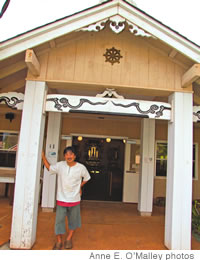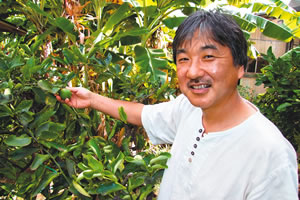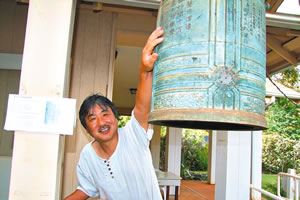A Place Where Awakening Happens

Rev. Noriaki Fujimori at the Waimea temple
The earth doesn’t shake and the firmament remains solid, but there’s a definite “ping” in the universe where Rev. Noriaki Fujimori, or “Fujimori,” as he likes to be called, is concerned. He is the sensei (teacher) of the Waimea Higashi Hongwanji temple who guides his 40 to 70 Buddhist temple members in researching their awakening.
Explaining this field of research, he says, “Buddha means awakening. To get awakening, we need to find what is the cause of suffering.”
In Buddhism, the way to find the cause of suffering, he explains further, is through four noble truths – that all beings are subject to suffering; that the cause of suffering is ignorance; that the ignorance can be overcome; and that there is a way to overcome the ignorance – via an eight-fold path.
Fujimori has been seriously investigating his own ignorance and gradual awakening since he was 18 years old and traveled from Japan to India with a friend. While there, he compared his life to the lives of many Indians and drew conclusions.

Rev. Fujimori in his ‘peace garden’
“I was spoiled,” he says. “I loved to collect things, had attachments to material things. After that I felt I should study Buddhism.”
Ping!
Returning to Japan, he studied philosophy and religion, ultimately earning a master’s degree in international studies – and traveling widely.
Decades later, he’s been to South and Central America, Thailand, Cambodia, Bangladesh, Sri Lanka, the Philippines and more – always meeting people, indigenous and otherwise, and studying not only Buddhism but also Islam and Christianity.
“I go many times to Hokkaido,” says Fujimori, who was born and raised on that northern island of Japan. “For over 10 years, I have an exchange program with them. Ainu indigenous people live there. I learn many things from them – they have a culture of oppression.”
He recounts the history of Japan confiscating Ainu lands, partitioning them and making them available to Japanese colonizers. What followed among the Ainu parallels what happened in the overthrow of the monarchy in Hawaii – the loss of language and culture led to the Ainu becoming alienated in their own land.

This bell was given to the Waimea Hongwanji in 1911
“I was born in Hokkaido, so maybe I was part of the problem,” he says. “When I go, I bring my Hawaiian friends.”
Ping!
Fujimori has found himself in hot spots around the globe and has plans for more of those kinds of uncomfortable trips that stretch him. There’s the Middle East, seat of Islam, Judaism and Christianity; and Italy, with its Catholic brand of Christianity that he wants to explore. He is going, he says, “to study, to learn many different things.”
At about this point into his explanations on awakening, Fujimori switches to the future of this first Shin Buddhist temple on Kaua’i to which he’s been assigned since three months prior to Hurricane Iniki. It was destroyed and rebuilt on his watch.
Some people want to stay at this Waimea temple, perhaps in retreat, as he stays at a temple in Hokkaido when he goes to Japan. But it would mean expansion.
He’d like to expand the organic garden at the temple, as well as enlarge the kitchen for cooking classes. He offers a talk story recipe in the bimonthly temple newsletter in his column, “Save the Earth from the Kitchen,” and sees it as a future book project.
His work with social justice issues, the peace movement and the environment all are part of his own awakening.
“All the missions, every temple, has a different way to do it,” says Fujimori. “In my understanding, one of the eight-fold paths is to understand differences and to dialogue with people of differences – this would fall into right views. To learn myself, I have to learn the way of awakening. Buddhism means to learn myself, but I cannot see myself. When we meet other people, I can see myself, oh, I’m very different.”
Fujimori invites all to meetings, classes and services on weekdays at 9 a.m. The temple’s Bon dance will be held Aug. 6-7 at 7:30 p.m. Waimea Higashi Hongwanji Temple is located just beyond the permanent craft fair on the makai side of the highway. Contacts: 338-1847, fujimori@hawaii.rr.com
You must be logged in to post a comment.




There are no comments
Add yours